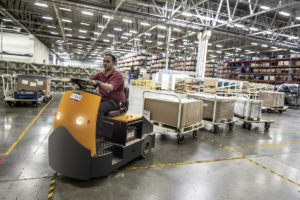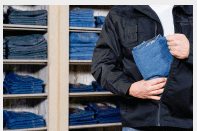
When stores are put together it is usually designed with appearance and functionality in mind. What you may not have thought about is how the structure and layout of a store might be helpful in discouraging shoplifting and other crimes. Have you ever paid attention to the gas station store layouts? Often the cashier island is in the center of the building and raised higher than the rest of the store. Low fixtures allow almost complete visibility of all areas of the store. It may not seem too important but if you have worked in Loss Prevention you know that this is an intentional design that helps reduce theft. By placing the employees higher they can see over customer’s heads and view what is happening in more parts of the store. Shorter gondola shelving may hamper how much merchandise can be displayed but by the same token visibility is enhanced. Those hiding places that shoplifters tend to congregate to become much harder to find.
It is important for store owners to keep theft in mind as they are planning how they are going to design their stores. Here are some additional ideas that you can consider as you build a store or perhaps redesign an existing one:
- Corral areas where high theft items are stocked. Corralling is the use of gondolas and cash register stands to create an enclosed department. There is only one way in and out and that requires passing the register. This design gives the managers a lot of control over the area and makes theft much more difficult. The drawback to a corralled department is that an employee has to always be dedicated to the department. That means it becomes a payroll expense. Many large chains that were utilizing this concept have moved away from it due in part to the cost of running it. It also ties down an employee who could otherwise help in other areas.
- Bright lighting throughout the store is important. Criminals seek shadows and darkness to cover their activity especially dark corners. Make these areas uninviting to crooks. Ensure you have lighting that hits every part of the store. This should include your stockrooms as well. Shoplifters are not the only criminals that will take advantage of your building, dishonest employees will too.
- For fire exit doors ensure the egress bars are set up with delays. Frequently shoplifters will fill up a shopping cart or bag with merchandise and hit a fire door with a getaway car parked right outside. A thief doesn’t want anything that will delay their exit from a building. A delay on a fire exit doesn’t have to be a long one but it does activate the door alarm when the egress bar is pushed. This alerts employees that a fire door is about to open and if someone is nearby they can respond to it quickly. A sign is required to be placed on the door or the bar alerting people that the door does have a delay. This can discourage many potential grab and run shoplifting incidents.
- Bollards or decorative barriers such as cement planters set up at the edge of the sidewalk outside of the front door(s) are an important feature. The use of such barriers discourage a vehicle being from driven through the entrance in a crash and run theft.
- Electronic article surveillance towers at all entrance and exit doors are a powerful deterrent to theft. Shoplifters become aware that anti-theft measures are in place as soon as they walk into the store. Using towers at employee accessible doors discourages associates from stealing from the workplace. A word of caution, don’t set up dummy towers and think you will achieve the same results. Criminals will figure out what is going on. Use Sensormatic equipment and Sensormatic tags and labels to get the real protection your store needs.
- Have counterfeit bill scanners and cash drop boxes at each register. Cashiers can scan all $20, $50 and $100 bills to prevent fraud. The drop box is used to remove the threat potential of short change artists, till tappers and even robberies.
- Finally, though they may seem expensive a few strategically placed cameras and Public View monitors can aid your managers in moving thieves out of hard to see locations.
Store design has a direct influence on theft and crime. Putting barriers up that will hinder crime and eliminating those obstacles that prevent your team from seeing your customers can improve the security of your building. Remove crime and you make your store safer while also making a positive impact on profits.
 Hiring employees is hard enough for retail owners without the pressures of hiring seasonal staff during the holidays as many stores are now doing. Under normal circumstances, managers and owners of retail businesses are stretched thin keeping a store operating efficiently. When turnover occurs more time is taken up as those managers are forced to focus their energies on filling holes in the weekly schedule. Job ads are posted and often paper applications are handed out as interested persons come in to respond to the ad or a “Help Wanted” sign posted in a window. Then there is the security risk that is involved in the hiring of new employees whether they are seasonal or to be a regular member of a team. A new hire carries an unknown quality and there is always the off chance that with even the best interview a criminal can slip between the cracks, the proverbial wolf in sheep’s clothing.
Hiring employees is hard enough for retail owners without the pressures of hiring seasonal staff during the holidays as many stores are now doing. Under normal circumstances, managers and owners of retail businesses are stretched thin keeping a store operating efficiently. When turnover occurs more time is taken up as those managers are forced to focus their energies on filling holes in the weekly schedule. Job ads are posted and often paper applications are handed out as interested persons come in to respond to the ad or a “Help Wanted” sign posted in a window. Then there is the security risk that is involved in the hiring of new employees whether they are seasonal or to be a regular member of a team. A new hire carries an unknown quality and there is always the off chance that with even the best interview a criminal can slip between the cracks, the proverbial wolf in sheep’s clothing. National retail chain stores often rely on a management team to handle all of the daily operations of a business. These positions vary from company to company but depending on the size and sales volume of that retailer there are different managers to oversee diverse functions. There may be soft lines and hardlines department managers, a freight manager, Human Resource Manager and a store manager. Some stores might only have a sales floor manager, freight manager, and a store manager who also functions as the human resources manager. For an independent business owner, these sub-managers might be a luxury that is not affordable to them. That means it is up to the store manager to oversee all store functions and if an employee calls out that may be one more job the manager fills for a day. This takes me back to an old saying I have heard, “Work smarter, not harder”. It is not possible for a store owner or a single manager to effectively perform all of the tasks associated with running a store every single day. Finding ways to lighten the load and improve efficiency can make life much better for a retail owner.
National retail chain stores often rely on a management team to handle all of the daily operations of a business. These positions vary from company to company but depending on the size and sales volume of that retailer there are different managers to oversee diverse functions. There may be soft lines and hardlines department managers, a freight manager, Human Resource Manager and a store manager. Some stores might only have a sales floor manager, freight manager, and a store manager who also functions as the human resources manager. For an independent business owner, these sub-managers might be a luxury that is not affordable to them. That means it is up to the store manager to oversee all store functions and if an employee calls out that may be one more job the manager fills for a day. This takes me back to an old saying I have heard, “Work smarter, not harder”. It is not possible for a store owner or a single manager to effectively perform all of the tasks associated with running a store every single day. Finding ways to lighten the load and improve efficiency can make life much better for a retail owner. I actually like and believe in all three of these things. When it comes to drugs they have to be the legal kind. All of us have seen the destruction that illegally used drugs cause. In a business environment, illegal drug use by an employee not only has an impact on their work performance but creates serious customer and legal issues for employers. An employee that is under the influence of any substance that influences their ability to do their job correctly or safely, will cause customers to question who they are doing business with.
I actually like and believe in all three of these things. When it comes to drugs they have to be the legal kind. All of us have seen the destruction that illegally used drugs cause. In a business environment, illegal drug use by an employee not only has an impact on their work performance but creates serious customer and legal issues for employers. An employee that is under the influence of any substance that influences their ability to do their job correctly or safely, will cause customers to question who they are doing business with.

 Wal-Mart has a unique way to cut down on shoplifting
Wal-Mart has a unique way to cut down on shoplifting